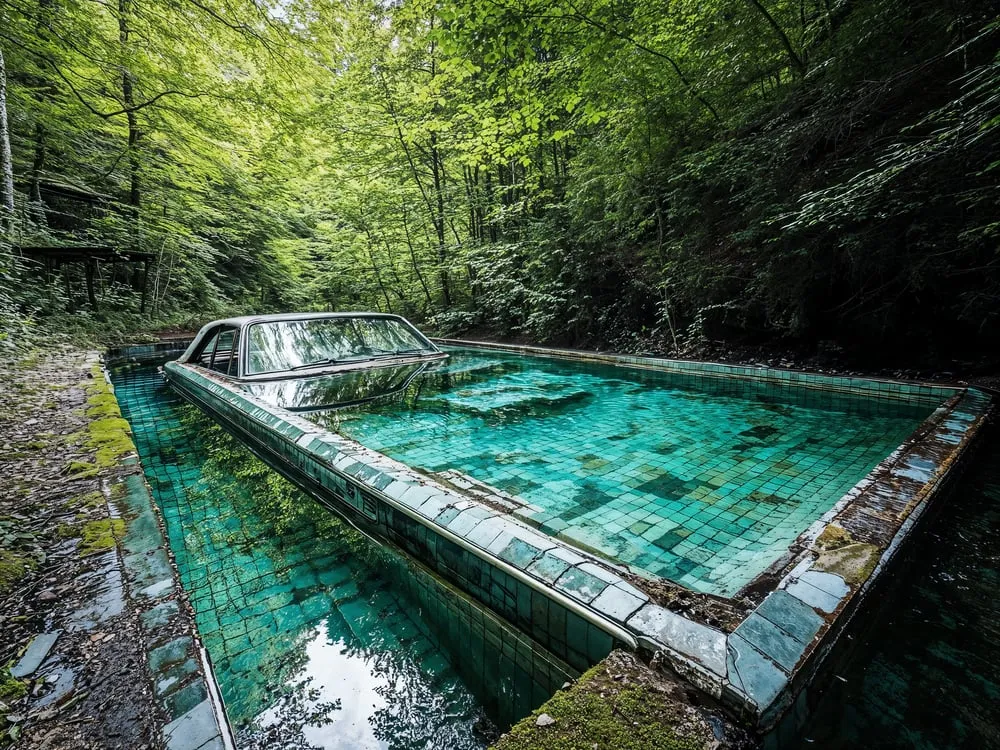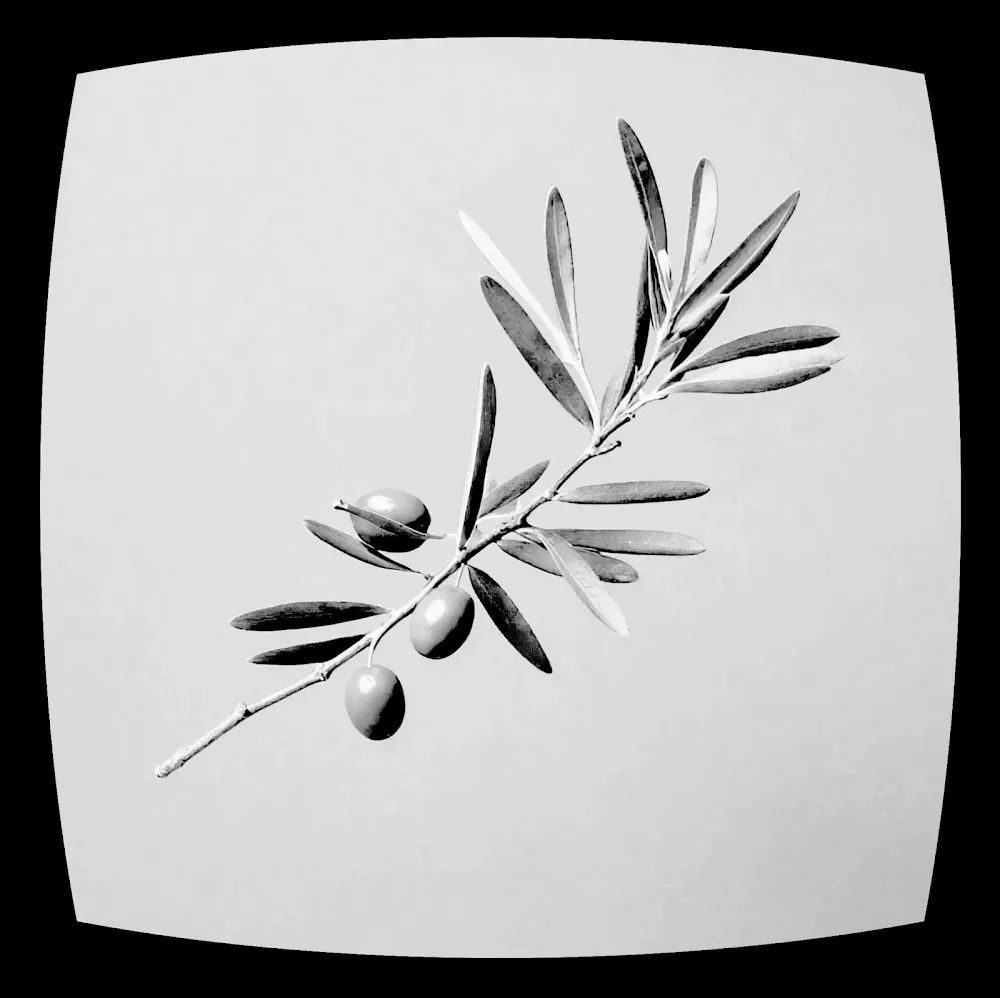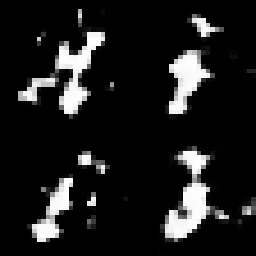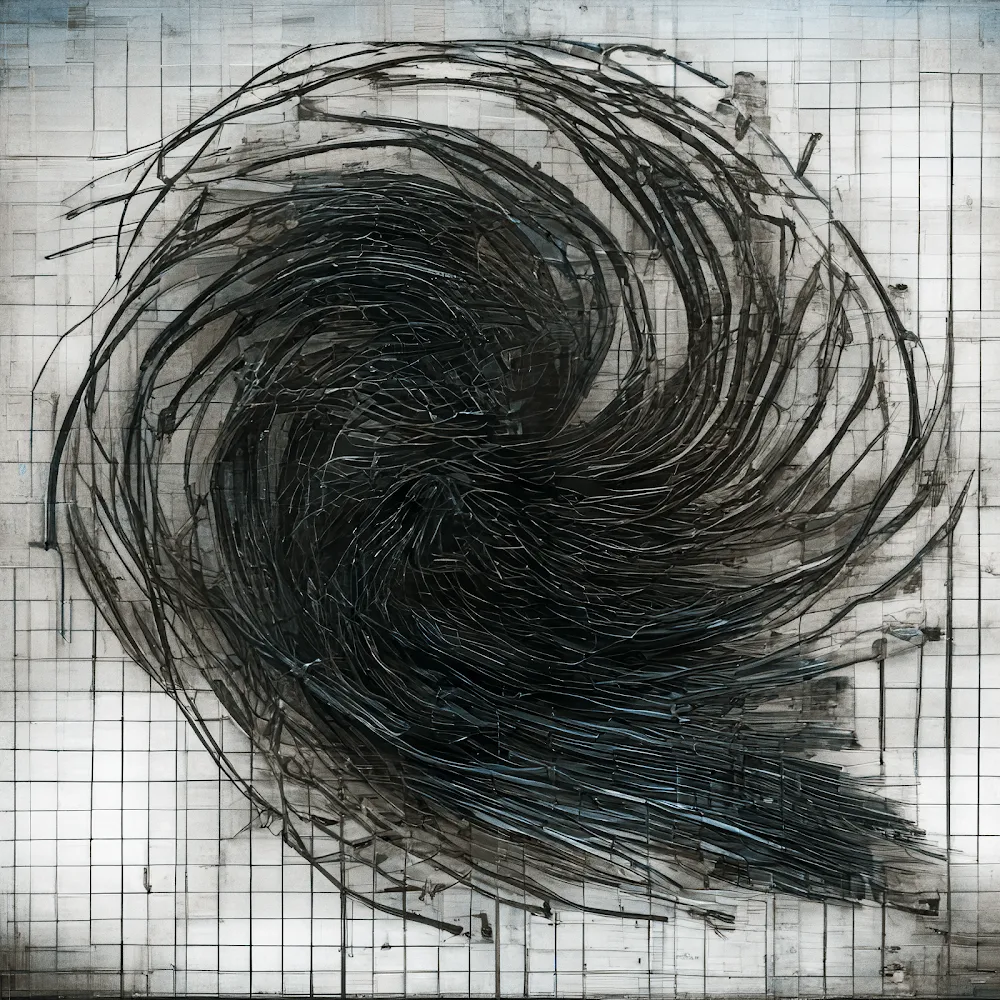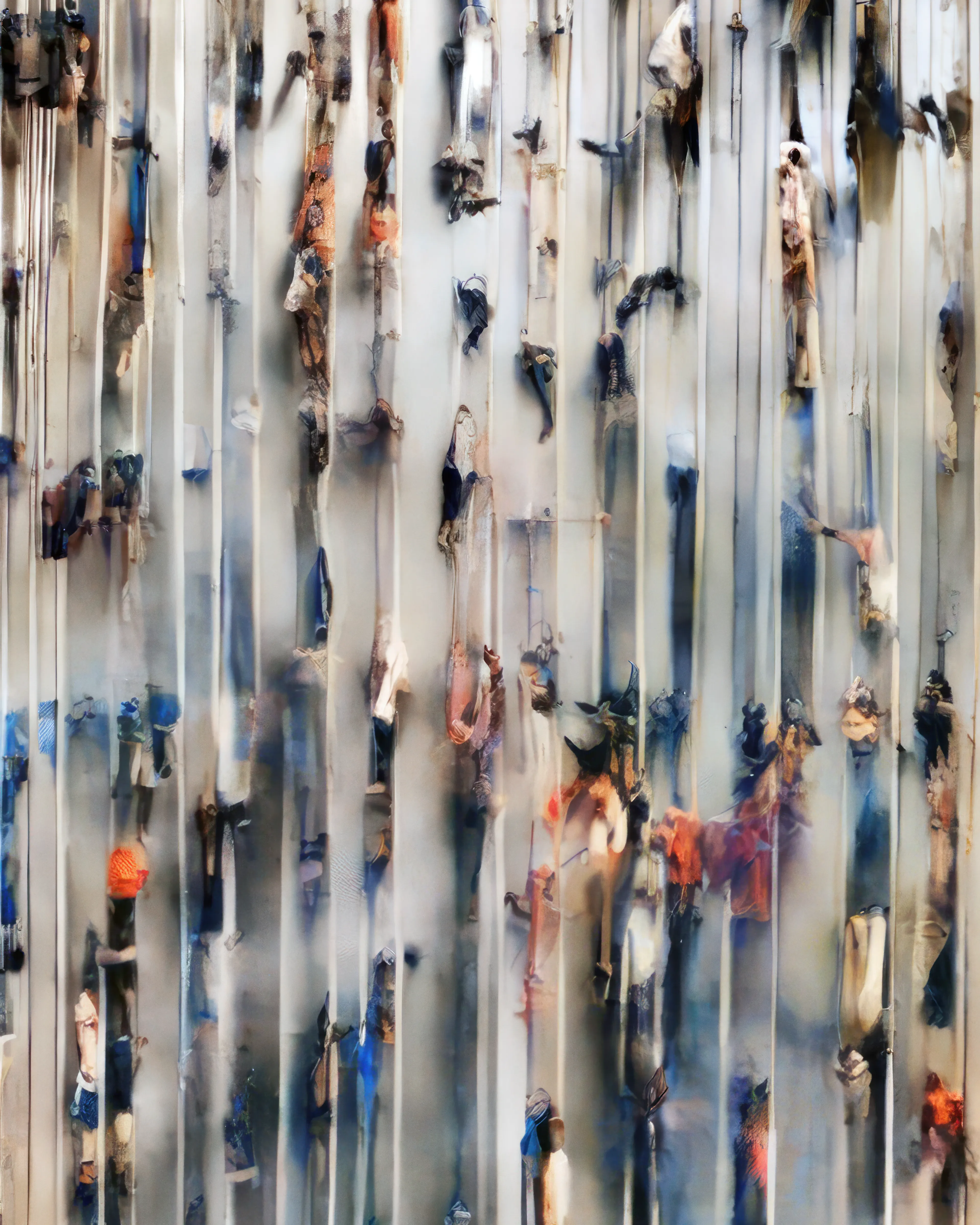Subscribe to get the latest on artists, exhibitions and more.
Will AI Replace Artists? Kevin Abosch at Central Saint Martins

Kevin Abosch in conversation with Mimi Nguyen at Central Saint Martins, University of Arts London. Image: Kevin Abosch, Sky Patrol Over Los Angeles, 2023. Courtesy of Galerie Nagel Draxler.
Mimi Nguyen: A warm welcome to Kevin who's joining us at the Central Saint Martins. It's a pleasure to see all of you. Kevin Abosch, a preeminent conceptual artist known for his work in multimedia installations and photography, has been exhibited worldwide. His pieces have graced the halls of major institutions like the Museum of Modern Art in Bogota or ZKM Karlsruhe. Kevin's art has captivated audiences everywhere, from Art Basel to the Paris Photo art fair. He's affiliated with the Nagel Draxler gallery in Berlin, which is at the forefront of integrating blockchain technology into the art world. They exhibit NFTs, and Kevin's synthetic AI works that have made a significant impact, especially at the solo booth in Paris Photo. For those in London, you'll have the opportunity to view Kevin's work at Frieze Cork St Gallery this weekend. Welcome, Kevin.
Kevin Abosch: Thank you. It's a pleasure to be here.
Mimi Nguyen: I've kept my introduction somewhat enigmatic, as there are various topics I'm eager to delve into with you. When did you begin experimenting with AI?
Kevin Abosch: I first identified as an artist in 1989, coincidentally the same year that the ZKM Center for Art and Media in Germany was established. It wasn't until a few years later that I realized the connection. Shortly thereafter, in the early '90s, I began dabbling with early computer vision technologies.
My background in microbiology unexpectedly provided me with a unique perspective. I had an idea related to analyzing Pap smear tests to detect cervical cancer risk. The alarming rate of false negatives in these tests was a significant health concern. I believed that by training a computer system to differentiate between normal and abnormal cells, we could address this issue. Although an earthquake in Los Angeles destroyed a vital database I was using for my research, more equipped scientists continued the work, and it's my understanding that the problem has since been largely resolved.
This early experience was indicative of a recurring theme in my life: leveraging emergent technologies in non-artistic ways before finding ways to incorporate them into my artistic practice. I've always been drawn to technology, learning to code at an early age and maintaining that relationship throughout my life, with only a brief hiatus during college. My work has always been about exploring how emergent technology can further my goals as an artist.
Mimi Nguyen: Your journey into technology began with science, which I find remarkable. Not many people had the opportunity to interact with computers so early unless they worked at a university or had parents who were researchers. It's intriguing to consider the impact of such early exposure to technology on one's life.
Kevin Abosch: That's absolutely correct.
Mimi Nguyen: What also intrigues me is the concept of machine learning. Our students might not be fully aware of what it entails. When you talk about the research you were doing and use terms like 'training' in the context of image recognition, it piques interest. Could you give us a brief overview of what this process involves?
Kevin Abosch: Sure. The 'black box' of machine learning varies, but it boils down to a simple formula: you collect data. This data forms the foundation for training a system, allowing it to develop a knowledge base from which insights can be gleaned. This could involve various types of data, like photographic or electromagnetic. We then apply mathematical algorithms to this data, which in turn generates new data. This new data ideally provides insights about the original input, or it could enable a system to execute commands based on its new knowledge.
In the early stages, this learning process was supervised by humans who decided what the system should learn. This leads to conversations about bias in AI, based on the type of data chosen for training. Today, we still use a similar formula but with more sophisticated algorithms and unsupervised learning methods, which don't require constant human input.
The ultimate goal is to emulate human learning, a milestone we haven't yet reached but is considered the Holy Grail of AI. In academic circles, we tend to talk more about machine learning rather than AI, unless we're discussing advanced unsupervised or deep learning. To the general public, however, it's all referred to as AI.
Mimi Nguyen: Do you think we've reached a stage where this resembles actual intelligence? With machine learning, we input data, recognize patterns through algorithms, and attempt to predict outcomes based on past data, considering the issues of bias. But does this constitute intelligence?
Kevin Abosch: We're at a stage that mimics intelligence well enough that many might accept it as such. Whether or not it truly is intelligence is up for personal and academic debate. Among my colleagues and myself, we don't believe we're there yet. It may be a bit of snobbery, or perhaps because AI hasn't yet achieved the potential many of us hope for. Despite decades of development, AI technology still feels nascent, like it's just beginning, especially with the advancements from OpenAI and the speculation about artificial general intelligence.
Mimi Nguyen: When did you manage to merge the creative and scientific aspects of your work? Was there a pivotal moment when you realized you could integrate AI or machine learning with art?
Kevin Abosch: My work with photography led me to explore the nature of substance and the relationship between the artist, the subject, and the mediating machine. These explorations naturally involved technology. For instance, I was among the earliest artists to use Photoshop, and I've experimented with lensless photography and other methods to create images. Military technology often pioneers these advancements, and I spend a lot of time researching what they have developed to see if it can be applied to my artistic practice.
In recent years, computational photography has blurred the lines of traditional photography, with AI and machine learning quietly altering images based on cultural preferences and other factors. These alterations are subtle and often unnoticed by the general public, but they can raise ethical questions, such as whether it's right to cater to societal biases in beauty standards.
These tools have revolutionized the way we create and perceive imagery, and they've been in our hands for longer than most people realize. Even the cameras in our smartphones use machine learning to enhance photos in ways we might not be aware of, shaping our perception of what photography is today.

Mimi Nguyen: Our course handbook includes a book on war's influence on technology, highlighting how many innovations, such as nanotechnology in our iPhones or wireless communication, originated from wartime needs. It's fascinating to see that many technological advances, both scientific and military, can be harnessed by artists. When you incorporate AI, especially synthetic AI, it introduces a new realm of expression. For your new projects, what's the significance of using AI?
Kevin Abosch: My exploration into AI is part of a broader quest to understand my identity and how I connect with the world. Years ago, I began to wonder what would happen if I fed my own photographs, taken with intention and care, into a machine. Would it be possible for the machine to learn from my imagery and then generate new works that are extensions of my art? I wanted to see if the resulting creations would evoke an emotional connection for me. This experimentation started years ago with early generative adversarial networks.
The first time I was truly impressed with the output was during a project called 'Nail.' I was looking for a simple, monochromatic subject that could be captured in my style due to the computational limitations of the time. I chose to photograph nails, a small data set that was manageable yet challenging for the algorithms.
Mimi Nguyen: Based on just 200 images?
Kevin Abosch: Yes, just 200. This is where it gets intriguing, especially for those familiar with this technology. Peers often question the small size of the data set, anticipating 'collisions' where the machine would simply replicate images rather than create unique ones. With a larger data set and a robust algorithm, you can generate millions of unique images without collisions.
Mimi Nguyen: [Referring to an image in the chat] With limited data, the system might not distinguish between a dog or a muffin, for instance. How did you manage to achieve distinct results with just 200 images?
Kevin Abosch: I approached this challenge differently. Many technical experts in this field aim to produce a high volume of distinct outputs, but as an artist, my goal was to create only a handful of unique images. This allowed me to take shortcuts and use what might be considered a less capable algorithm. I was willing to accept the trade-off of generating a limited number of high-fidelity images. This often leads to debates with other artists about the robustness of technology versus artistic intent.
Mimi Nguyen: It seems to come back to the fundamental question of what constitutes art, often defined by intention. Whether it's achieving technical excellence or creating something that resonates as artwork, intention is key. At Paris Photo, we saw early text-to-image attempts presented as artworks, igniting discussions about whether these are historical documents or art.
Kevin Abosch: Exactly. There was initial skepticism about the legitimacy of the work, but it was quickly accepted as a historical document rather than art. It raises the question of whether a consensus can transform a historical document into art.
Mimi Nguyen: Regarding your 'Nail' project, when you see the machine's output, do you recognize yourself in it? And if someone fed an algorithm with all your works, would the result still be considered your art, or does it become something else?
Kevin Abosch: Well, my body of work is so varied aesthetically that it would be challenging to replicate it consistently. If someone were to generate work based on my art, we'd delve into complex discussions about intellectual property. It's a conversation that's still evolving, and while I don't get too involved in it personally, it's a pressing issue for many in the field.
Today's topic is whether AI will replace artists. I think regulation could play a significant role in this. We live in structured societies with legal frameworks that, although decaying, still function to an extent. For instance, governments could legislate against using images or creating synthetic images from models based on other artists' work without consent. It's challenging to prove such cases, though, and there's a long history of artists explicitly using others' work to make statements or for aesthetic reasons, which has always been met with both proponents and detractors.
Mimi Nguyen: But what about inspiration? Say I grew up watching Woody Allen films and become a director influenced by his style. You can see this kind of inspiration in the works of Noah Baumbach, who is sometimes referred to as the new Woody Allen. Now, if an AI, like Midjourney, is fed with public mass images like the Mona Lisa and creates new works, can we call that inspiration? Or is it legally questionable—stealing someone's style or just drawing inspiration?
Kevin Abosch: Legally, I'm unsure, but ethically it's a different matter. AI models, like Midjourney, have biases; they wrap outputs in a homogeneous aesthetic. For instance, many images have a steampunk vibe. If a model's style is so distinct, then perhaps the AI is contributing artistically. Certain tools contribute significantly to the creative process and are immediately recognizable, such as oil paint over watercolor.
Artists are influenced by various factors, often subconsciously. Whether AI models are mere collages or something more is up for debate. They're like DNA being reassembled into new forms. There are biases, for example, in the representation of certain animals or people that can lead to repetitive patterns.
Mimi Nguyen: So, could the AI model be considered the artist if it defines the work's aesthetic?
Kevin Abosch: While AI is a tool, it does influence the art significantly. Artists using AI may talk about collaborating with the machine, but I think this is an anthropomorphization I disagree with. The artist brings their experience, intention, and narrative to the table, while the AI, as a mirror/prism, reflects and distorts this input, often revealing a complex reflection of the artist's subconscious. The process changes how artists perceive and feel, permanently altering their perspective.
We shouldn't view AI as replacing artists but as augmenting them. Artists are not being replaced; they're exploring how to coexist with and utilize AI. The artist decides when the work is complete. It's not a matter of being replaced; it's about augmentation and integration.
Mimi Nguyen: Could this be intrusive? A paintbrush or Photoshop is under the artist's control, but with AI, the outcome is less predictable.
Kevin Abosch: Control with AI is different. It's not about mastery over craft but about embracing the unknown and integrating it into the creative workflow. There's more control than people realize, especially once you become accustomed to the AI's influence. Artists who are not afraid of the unknown and who can work with this lack of control will master the use of AI in their art.
Regarding the volume of art created, the issue becomes whether the work is original or just visual plagiarism. We must judge AI-created art just like any other art form—by its ability to resonate with us, not by how many pieces we scroll past on Instagram.
Art schools and applications may need to adapt to this new landscape where AI can quickly generate art and even movies. The process and labor involved in traditional art creation might be transformed, but it's not just about speed. It's about originality and the artist's unique touch.
Ultimately, the role of artists in society is more than just creating; it's about guiding the public through the integration of AI into everyday life. Artists and philosophers alike will shape how society understands and interacts with AI.
Mimi Nguyen: It's interesting to see institutions without deep knowledge of AI art seeing it coming to art fairs. The art world is indeed evolving rapidly.
Kevin Abosch: Certainly, discussions about the importance or significance of art might label us elitists among some of our acquaintances. But the real question is the significance of an artist's body of work or an individual piece. If you're not equipped with the tools or awareness to discern what makes art significant, you might be out of your depth. A more critical issue is how artworks gain entry into prestigious institutions.
We've seen instances where wealthy individuals ensure the artists they favor are represented in museums, perhaps even funding a new wing with the stipulation that certain works be displayed. This raises concerns about the influence of wealth on artistic recognition within institutions.
Mimi Nguyen: There's also concern about writers being replaced by AI, similar to the fear within the academic world regarding AI-written papers. There's a resistance to acknowledging AI as a tool, whereas in the art world, there seems to be a growing understanding of AI as just another tool, elevating the importance of concepts and ideas. However, with the accessibility of AI, becoming a distinguished artist may now be more challenging due to increased competition.
Kevin Abosch: Yes, just like anyone can buy a brush and oil paint, it doesn't guarantee mastery of the art. The same goes for photography; with the advent of affordable technology, everyone can take photos. Still, only a few can differentiate between a casual snapshot and true artwork. When a technological tool becomes widespread, the real excitement lies in finding those who use it in a unique and innovative way.
Mimi Nguyen: Tell us about your process, for instance, the work displayed behind you.
Kevin Abosch: That particular work involved training on a data set comprised mainly of film-related materials—transparency films, slides, various types of film. I also captured thousands of images of fashion accessories and parts of bodies. Unlike public models like Mid Journey, I used stable diffusion running locally on my computer to process personal data sets, not influenced by public images. This approach allows me to produce images that, while not striving for hyperrealism, feel personal and connected to me.
Mimi Nguyen: This opens up concerns about deep fakes and recreating memories or moments that never happened, which seem so real and familiar. It's a potential to twist reality, which is worrisome, especially considering implications for politics or other sensitive areas.
Kevin Abosch: It's not the first time truth has been challenged. The potential for manipulation and misinformation through tools like Photoshop has been around for a while. What I find is that people aren't really looking closely anymore. They're not seeing the subject as it is. In my work, I've focused on distilling emotional value, helping me create images that feel very personal, akin to opening a Pandora's box that challenges our perception of reality.
Mimi Nguyen: At Paris Photo, there was a work that a photographer submitted an AI-generated photo to a contest, won, but then refused the prize, saying it was just an experiment with AI. Yet the jury insisted on awarding the prize regardless of the AI involvement.
Kevin Abosch: That was more of a statement about the current state of affairs rather than an endorsement of AI art. The strict ethical standards in photojournalism are well known. This incident highlights that people are eager to jump on the fear of AI without really looking closer at the intent behind its use.
Mimi Nguyen: Roope mentioned that he uses AI to create images that cameras cannot, which resonates with the idea that AI is another tool enabling us to do things previously impossible. Hopefully, this leads to more interesting works in the coming years.
Kevin Abosch: Exactly. The term 'synthetic photography' I use describes works where photographic input data results in something resembling traditional photography. There's a point where the action becomes so severe that it morphs into something more illustrative or painterly, and that's when I'd categorize it differently.
Kevin Abosch
Kevin Abosch is an Irish conceptual artist known for his works in photography, sculpture, installation, AI, blockchain, and film. Abosch’s work addresses the nature of identity and value by posing ontological questions and responding to sociological dilemmas.
Abosch’s work has been exhibited throughout the world, often in civic spaces, including The Hermitage Museum, St. Petersburg; The National...
Galerie Nagel Draxler
Galerie Nagel Draxler (formerly Galerie Christian Nagel) was founded in 1990 and operates in Cologne, Berlin, Munich and Meseberg. They are proud to be a gallery that has a history, a present and a future. An emphasis lies on an established artist generation, that has been showing with them since the beginning and whose work has been strongly influential for following generations. Their...
Mimi Nguyen
Mimi is a Creative Director at verse. She is a assistant professor at Central Saint Martins, University of Arts London where she leads the CSM NFT Lab. Her background is New Media Art, having previously studied at the Berlin University of the Arts (UdK) and Academy of Fine Arts in Warsaw. She now also teaches at Imperial College London, Faculty of Engineering, where she leads Mana Lab - a “Future...
